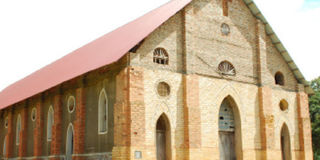Narozali, Masaka’s 115- year-old church building

The 115-year-old structure of Our Lady of the Rosary Church at Narozali, Masaka District. Photo by MARTINS E. SSEKWEYAMA
Besides the famous Villa Maria Cathedral where the first two African priests; Reverend Fathers Victor Mukasa Womeraka and Basil Lumu were ordained in 1913, Masaka sub-region, has more to rejoice about when it comes to historical sites.
The Catholic Evangelisation in the area begun in 1891 by the White Fathers led by the famous French priest; Rev Fr Henry Streicher who was later consecrated bishop of the whole central region province.
Streicher together with several White Fathers established his administrative centre at Villa Maria in the present day Kalungu District, where they accordingly erected permanent church structures for their converts to converge for prayers.
A few years later (about four), the White Fathers started constructing another Church at Narozali village in Buwunga Sub-county, about seven miles south of Masaka Town with the aim of taking the gospel closer to the people other than trekking to Villa Maria.
By 1896 the White Fathers had managed to construct a permanent church structure in the area and because of its posture and size, it was accordingly elevated to a parish status in 1900, which Bishop Streicher put under the direct management of Fr Graph Peire as the first parish priest.
The parish was named after Our Lady of the Rosary and it has existed to date.
According to Rev Fr Kennedy Kinsambwe, the current parish priest, the Cathedral has stood a test of time because of the highly good workmanship exhibited during construction.
Fr Kinsambwe explained that among the White Fathers, there were carpenters and builders who corroborated with the new native Catholic converts and eventually put in place such a firm structure that has stood for 115 years.
The church, with a seating capacity of 2,000 worshippers, was built on a very strong foundation that shades a true picture of good workmanship.
Adjacent to the church is a priest’s house with the same longevity. Both structures were uniformly built with two feet size of the walls which have guaranteed their strength for all these years with no major renovations.
The church and the priest’s house remain one of the oldest brick buildings not only in the Masaka sub-region, but also in the country. The structures were built with unbaked bricks and strong supporting pillars, and until recently they survived with their original iron sheets.
“The quality of work that was done here is of rare characteristic. For all these years, the two buildings have survived on their initial works,” Fr Kinsambwe noted.
He, however, added that the church is currently undergoing major renovation that begun with replacing the roof and veranda to enable it attain a modern facelift, but without completely removing its historical shape and workmanship.
Fr Kinsambwe reveals that the first indigenous priests, Fr Mukasa and Fr Lumu were coincidentally sent to the same parish and it’s where they started practicing their priestly vocation immediately after ordination in 1913.
Sylvia Namulindwa is among the many parishioners that are so proud of living in this historical parish.
She says besides the significant spiritual contribution to the area, the parish came along with other social benefits that have supported the area for many decades. “As a community, we praise God that he inspired the White Fathers to begin the work in such a remote area,” she says.
Untapped gem
But the parish with all its valuable historical structures, are just preserved for the admiration of the local Christian community who only stop at enjoying telling its history and legacy to the different generations and people that mind to ask about it.
Apart from taking pride in the church and speaking about its significance in the history of the Catholic faith in the sub-region and the country as a whole, during Holy masses, there are hardly any clear arrangements made to turn the place into a tourist site even when it has the potential of becoming one.
However, Fr Kinsambwe, could provide a turning-point for the parish that will probably transform it into a more attractive place anyone would wish to visit. He is highly envisioned to having the intended renovations accomplished during his tenancy as the parish priest.




